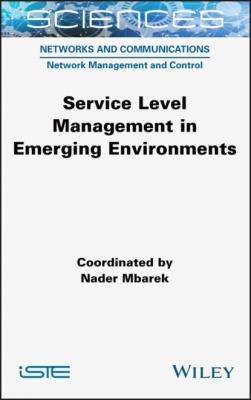ТОП просматриваемых книг сайта:
Service Level Management in Emerging Environments. Nader Mbarek
Читать онлайн.Название Service Level Management in Emerging Environments
Год выпуска 0
isbn 9781119818328
Автор произведения Nader Mbarek
Жанр Отраслевые издания
Издательство John Wiley & Sons Limited
Table of Contents
1 Cover
4 Preface
5 1 Service Level Management in the Internet of Things (IoT) 1.1. Introduction 1.2. IoT: definitions 1.3. IoT: an overview 1.4. Security management and privacy protection in the IoT 1.5. QoS management for IoT services 1.6. QBAIoT: QoS-based access method for IoT environments 1.7. Conclusion 1.8. References
6 2 Service Level Management in the Cloud 2.1. Introduction 2.2. The Cloud environment 2.3. Service level and self-management in the Cloud 2.4. QoS guarantee in Cloud Networking 2.5. Conclusion 2.6. References
7 3 Managing Energy Demand as a Service in a Smart Grid Environment 3.1. Introduction 3.2. The Smart Grid environment 3.3. Demand management: fundamental concepts 3.4. Demand-side management 3.5. Techniques and methods for demand scheduling 3.6. Conclusion 3.7. References
8 4 Managing Quality of Service and Security in an e-Health Environment 4.1. Introduction 4.2. e-health systems 4.3. QoS in e-health systems 4.4. Security of e-health systems 4.5. Conclusion 4.6. References
9 5 Quality of Service Management in Wireless Mesh Networks 5.1. Introduction 5.2. WMNs: an overview 5.3. QoS in WMNs 5.4. QoS-based routing for WMNs 5.5. HQMR: QoS-based hybrid routing protocol for mesh radio networks 5.6. Conclusion 5.7. References
10 6 Blockchain Based Authentication and Trust Management in Decentralized Networks 6.1. Introduction 6.2. The Blockchain Authentication and Trust Module (BATM) architecture 6.3. Evaluating BATM 6.4. Conclusion 6.5. References
11 7 How Machine Learning Can Help Resolve Mobility Constraints in D2D Communications 7.1. Introduction 7.2. D2D communication and the evolution of networks 7.3. The context for machine learning and deep learning 7.4. Dynamic discovery 7.5. Experimental results 7.6. Conclusion 7.7. References
12 8 The Impact of Cognitive Radio on Green Networking: The Learning-through-reinforcement Approach 8.1. Introduction 8.2. Green networking 8.3. Green strategies 8.4. Green wireless networks 8.5. How CR contributes to green networking 8.6. Learning through reinforcement by taking into account energy efficiency during opportunistic access to the spectrum 8.7. Conclusion 8.8. References
14 Index

